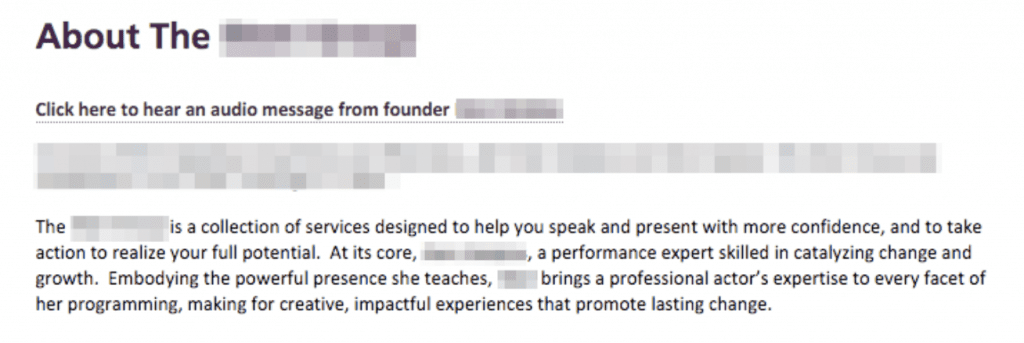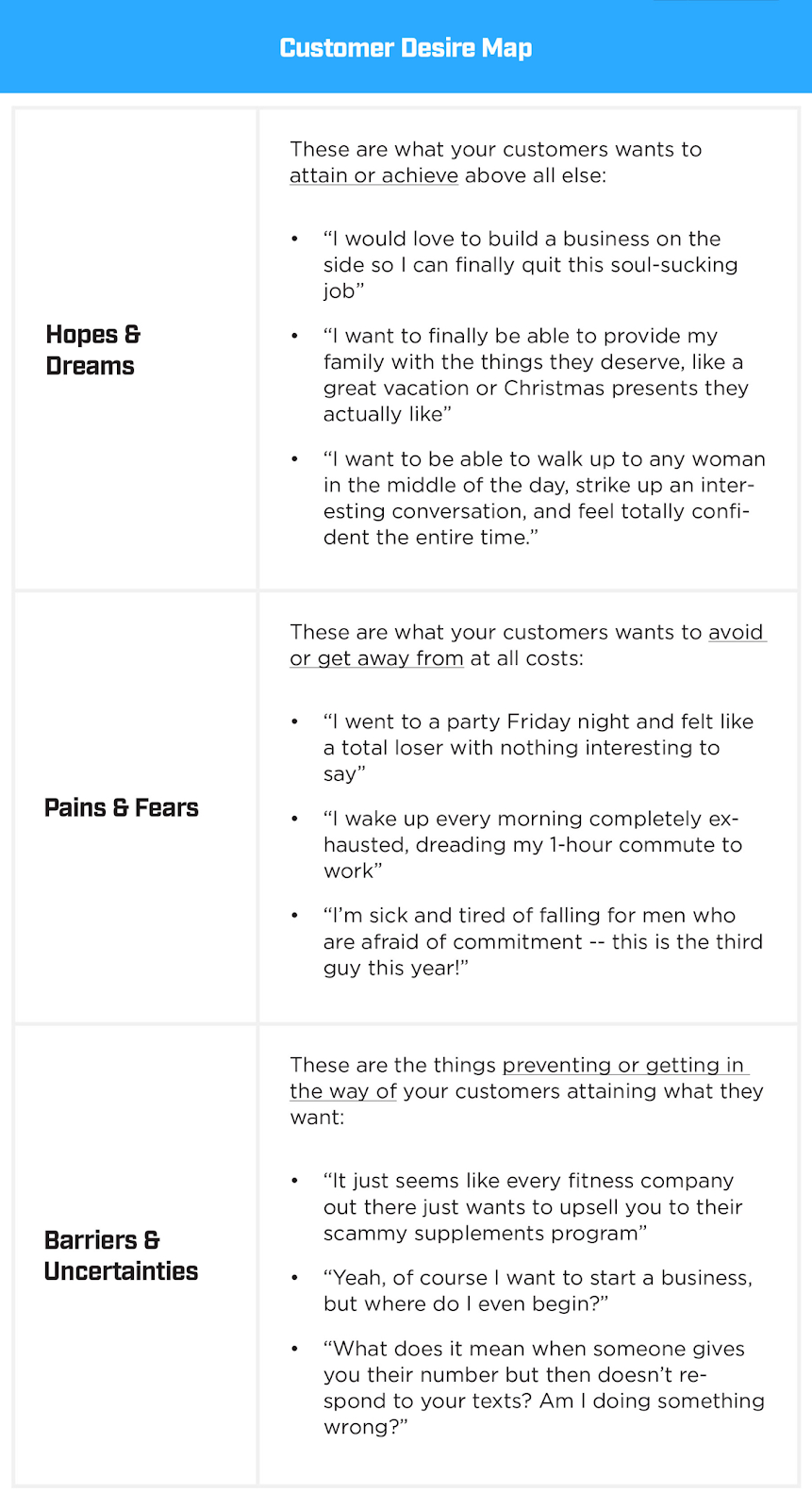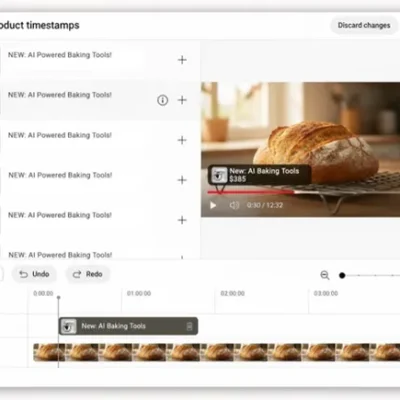Good copy feels alive because it speaks the reader’s language, calls out their frustrations, and shows how life gets better with your solution. The difference comes down to whether your words connect emotionally and move people to act.
Good Copy vs. Bad Copy
Before you can learn how to write good copy, you need to learn the difference between good and bad copy. Let me show you two examples, and you can see which one makes you want to yawn.

If you’re thinking, “I ain’t reading all that!”, I don’t blame you. The text is emotionless, tells us virtually nothing, and worst of all, it’s boring.
Now compare it to this example:

It’s fairly straightforward. It addresses a problem, offers a solution, and has a clear call to action.
Good copy talks to the reader about their problems, their wants, and their world, showing exactly how life gets better with your offer. It speaks their language, connects on a human level, and delivers a solution they actually care about.
Over the years, I’ve tested, refined, and mastered copywriting by studying every book, course, and resource I could find—and applying it to grow my own business sales by 20 times. I know firsthand what works and what doesn’t when it comes to writing copy that sells.
3 Steps for Writing Copy That Converts
Here are three practical steps for writing copy that doesn’t just sound good, but also leads your reader to action.
Step 1: Become an ethical mind reader
You can’t write compelling copy by sitting at your desk and guessing what your audience wants. You need to step into their world and understand it better than they do themselves.
This is what separates amateur copywriters from professionals who command premium rates. Most businesses fail at copywriting because they write from their own perspective. They talk about features instead of benefits, use jargon instead of plain language, and focus on what they want to say, not what their audience needs to hear.
The real strategy is to immerse yourself in your audience. Spend days, weeks, or even months talking with your target customers about what they want. If you’re targeting a specific market, go where they are.
For example, if you’re writing for busy entrepreneurs, don’t just assume they want “time management solutions.” Go into entrepreneur Facebook groups and see how they actually talk about their time struggles. You might find phrases like, “I’m drowning in my to-do list,” or, “I feel like I’m spinning my wheels all day but getting nowhere.” Those exact words are copywriting gold because they’re real and incredibly relatable.
The best copywriters spend 60–80% of their time in this research phase because every winning headline, hook, and call to action is built upon those insights.
Step 2: Map out what really drives your customers
Once you’ve stepped into your audience’s world, it’s time to make sense of what you’ve learned. This is where the Customer Desire Map comes in.
It’s a simple tool that captures the three core elements behind every buying decision: hopes & dreams, pains & fears, and barriers & uncertainties.
When you understand these drivers, you gain an advantage over competitors who are selling based on guesswork or the blind hope that something will stick.

Hopes & dreams
Get clear on what your customers truly want—not just the surface-level desires, but the deeper dreams they’re chasing. Consider these questions:
- What does success look like for them?
- What kind of transformation are they craving?
Whether it’s freedom, status, income, confidence, or peace of mind, your job is to connect your offer directly to that future they’re excited about.
Pains & fears
Understand what’s keeping them stuck or preventing them from achieving their goals. Consider these:
- What problems are getting worse over time?
- What are they tired of dealing with?
These are the frustrations they vent about, the silent struggles they carry, and the worst-case scenarios playing in their heads late at night. They’re looking for results, and they’re trying to escape pain. Tap into that. Speak to what they’re afraid will happen if they don’t change, and show them that you understand and care.
Barriers & uncertainties
People hesitate when things feel unclear, complicated, or risky. Maybe they’ve tried similar solutions before and didn’t get results. Think about these issues:
- What’s stopping them from taking action right now?
- What have they tried before that didn’t work?
- What excuses do they make to themselves?
Maybe they’re not sure if your offer is right for them. Good copy removes those doubts by making things simple, answering their unspoken questions, and proving that they can trust you.
Collect as many insights as you can here, spending at least a few days in this stage. The more thorough this stage is, the stronger and more emotionally compelling your copy will be.
Step 3: Write using their exact words
Stop writing like a corporate robot and start writing like a human who actually understands what your customers are going through.
This is where many new copywriters drop the ball. They gather all that valuable research and then water it down into “professional” business speak.
The secret is simple. Use the actual phrases your audience uses when describing their problems and desires. If someone in a Facebook group says, “I’m so tired of my clothes not fitting right,” do not translate that into “seeking wardrobe solutions for body confidence.” Use their exact words: “tired of clothes not fitting right.” Those words have emotional weight because they are expressed authentically by someone with that exact frustration.
In my business, we’ve taken exact quotes from our readers and used them in our sales copy, and the results have been incredible. If someone says, “Everyone keeps telling me to follow my passion, but I don’t know what my passion is,” that can become a headline that connects instantly. People see it and think, “That is exactly how I feel. This person gets me.”
As you write, weave in all three parts of your Customer Desire Map. Here’s a quick example:
- Hopes & dreams (create desire): “Imagine never worrying about money again.”
- Pains & fears (create urgency): “Stop lying awake at 3 AM wondering if you’ll ever get ahead.”
- Barriers & uncertainties (remove friction): “Even if you have tried budgeting before and failed, this is different.”
The goal is to make your reader feel understood instead of just being pitched to. When someone reads your copy and thinks, “This person is reading my mind,” you’ve won half the battle.
Writing Tips That Make Copy Impossible to Ignore
Now that you understand the foundation, here are five writing techniques that will make your copy stand out.
1. Read everything out loud like you’re talking to a friend
This single habit will improve your copy faster than any advanced technique.
When you read silently, your brain smooths over clunky sentences and fills any gaps without you even noticing. But when you read out loud, you hear exactly what your reader will hear—every awkward phrase, every confusing sentence, and every spot where the flow breaks.
If you stumble while reading aloud, your readers will stumble too. And stumbling readers stop reading. Delete or rewrite any sentence that does not flow naturally when spoken.
Your copy should sound like a conversation with a smart friend over coffee, not a presentation to the board. For example, instead of writing “Our comprehensive solution facilitates optimal outcomes for your financial management requirements,” say “We will help you finally get your money under control.”
The second version is what you would actually say to a friend, and it is far more digestible and memorable for your audience.
2. Paint pictures with your words instead of just stating facts
Your brain processes images 60,000 times faster than text, so vivid descriptions will always beat bland statements. When you paint a picture with words, you help readers experience and visualize the situation instead of just understanding it. The difference can be dramatic.
Here’s an example:
- Bad copy: “I don’t like commuting.”
- Good copy: “Every day I wake up and think, I can’t take another 45 minutes of sitting in bumper-to-bumper traffic to get to a job I hate.”
The second version puts you right there in the car, feeling the frustration, checking the clock, dreading the day ahead. You can practically smell the exhaust fumes and feel the stress building in your shoulders.
This works because specifics are more believable than generalities. When you say “I made more money,” people think “Sure, maybe.” But when you say, “I made an extra $3,247 last month while my kids were sleeping,” people will think, “Wow, tell me how.”
The more specific and visual your descriptions, the more real they feel in your reader’s mind.
3. Replace weak words with power words (but keep it conversational)
The right words can turn copy that people skim past into copy they can’t ignore.
Power words trigger emotion, but they have to match how your audience actually talks. For example, “overwhelming” might hit harder than “terrifying” if you’re writing for busy parents, while entrepreneurs might connect more with “game-changing” than “revolutionary.”
The goal is to sound vivid and real, but not like you’re trying too hard to sound smart—or like you’re a walking thesaurus.
Start building a collection of power words that fit your brand voice and your audience’s language. Swap weak words like “good” for “outstanding,” “bad” for “disastrous,” or “different” for “groundbreaking.” Then read them aloud and ask yourself, “Would I actually say this to a friend?” If it sounds forced, tone it down until it feels natural.
4. Write tight, then make it tighter
Every word in your copy needs to earn its place by building desire, addressing objections, or moving your reader closer to taking action.
Your first draft is just the beginning. It doesn’t have to be perfect, because the magic happens in editing, when you cut ruthlessly and polish relentlessly.
Start by getting all your ideas on paper without worrying about length. Then go back with a machete and remove anything that does not directly serve your main goal. Ask yourself: “Does this sentence make my reader more likely to buy?” If the answer is no, or even maybe, cut it.
Look out for common word wasters such as “really,” “very,” “quite”, “rather,” “basically,” and “actually.” These rarely add meaning and often weaken your copy. Instead of “This is really important,” say “This is crucial.” Instead of “You should probably consider,” say “You need to.”
Professional copywriters often cut 30 to 50% of their first draft, and the final version is always stronger. Your reader’s attention is limited. Every unnecessary word is a potential exit point.
How to Make Money Writing Copy
Copywriting is one of the highest-paid skills in business because great copy directly generates revenue. Companies will pay premium rates for copy that converts, and there’s always a high demand surrounding this skill.
The best part is you don’t need years of experience to start earning good money. Great copywriting follows proven formulas and structures, which means you can go from a complete beginner to earning a solid income faster than you could with most other skills.
Here’s how you can turn your copywriting skills into a feasible income.
1. Start practicing with everything around you
Before landing your first client, build your copywriting muscles with examples that demonstrate you know what you’re doing.
You can practice anywhere, anytime, without special tools or permission. Pick objects around your house and write persuasive product descriptions for them. How would you sell a coffee mug, a desk lamp, or your old running shoes? This helps you uncover benefits and emotional appeal in everyday items, which is the same skill you will use for clients.
Study effective sales pages from companies you admire and rewrite them in your own voice. Improve them by tweaking the headline, reshaping the offer, or addressing missed objections. This sharpens your instincts and style.
Challenge yourself to write 100 headlines a day for 30 days. Write for news stories, Instagram posts, personal problems, and big dreams. The more you practice, the easier it becomes to craft hooks that grab attention fast.
Keep a swipe file of copy that makes you want to buy something you do not need. Screenshot emails, save ads, and bookmark sales pages. Study them when you’re stuck and ask, “What makes this so compelling?” This collection can become your go-to inspiration library for future projects.
2. Build your portfolio
Creating spec work for brands that you admire is one of the fastest ways to create a standout portfolio.
Choose three to five companies and rewrite their website copy, product descriptions, or email sequences. Explain why your version works better, such as how it addresses customer pain points more directly or strengthens the call to action.
Focus on industries you’re passionate about or have experience in—such as fitness, tech, or finance—to show range in your writing skills.
It’s helpful to also share your thought process behind the copy so potential clients can see that you can capture a clear strategy and put it into compelling words.
3. Find your first clients where they’re already looking
Do not spend your energy convincing people they need copywriting.
Instead, go where clients are actively seeking it and already understand its value. Start with freelancer platforms like Upwork or Fiverr, where businesses post specific projects with clear budgets and expectations. Share your practice work to prove you can deliver, even if you are just starting.
Search LinkedIn for marketing managers, founders, or entrepreneurs in industries you care about. Review their posts or websites for weak copy, then reach out with tailored suggestions for improvement instead of just sending generic pitches.
Check job boards like Indeed, ProBlogger Jobs, or AngelList for freelance and long-term roles that can provide steadier income once you prove your worth. When you approach potential clients, always lead with value. Instead of saying you are looking for work, point out a gap in their copy and offer a quick fix or rewrite. This approach positions you as a problem-solver rather than just another freelancer asking for a job.
4. Price yourself based on value, not hours
Many new copywriters leave massive amounts of money on the table by undercharging. They charge based on the time spent on the project rather than the results delivered. A sales page that takes 10 hours to write but brings in $100,000 should not cost $500.
Start by understanding what good copy is worth to your client. If your email campaign helps sell 50 extra units of a $200 product, that’s $10,000 in revenue, making a $2,000 fee a smart investment for them.
Research what experienced copywriters charge. Sales pages often range from $1,500 to $10,000+, email sequences from $150 to $500 per email, and ads from $300 to $1,000 each.
When quoting your rates, tie your fees to the potential results. Instead of “This sales page costs $3,000,” say “This page can help you convert 15–20% more visitors, potentially adding $50,000 in revenue this year. My fee is $3,000.” By doing so, you can clearly illustrate the value your service can provide to the business, showing how it’s a worthwhile investment.
5. Scale up by specializing and building relationships
After a few successful projects, consider narrowing your copywriting specialization. Generalists compete on price, but specialists compete on expertise—and expertise commands higher rates.
You can specialize by industry (healthcare, SaaS, e-commerce) or by copy type (email marketing, sales pages, ads). Pick a niche with steady demand but enough focus to position yourself as the go-to expert.
To build your credibility, always ask happy clients for testimonials and referrals. Make it easy for them by giving a short, clear description of what you do and the type of clients you help, so they can easily pass your name to the right people.
It’s also helpful to prioritize long-term client relationships. Retainer clients for email marketing, quarterly sales page refreshes, or ongoing ad copy means predictable income and a deeper understanding of the business. These partnerships often lead to bigger projects and referrals as well.
If you’re serious about making this your career, here is a more in-depth guide on how to become a copywriter.
Living Your Rich Life
Living your Rich Life as a copywriter means having the freedom to choose work that excites you and say no to what doesn’t.
Once you master the craft, you can write from anywhere, charge premium rates, and work with people you genuinely enjoy. You’re no longer just trading time for money; you’re building income on your own terms. Whether that means traveling more, spending extra time with family, or funding a passion project, great copywriting skills can get you there.




